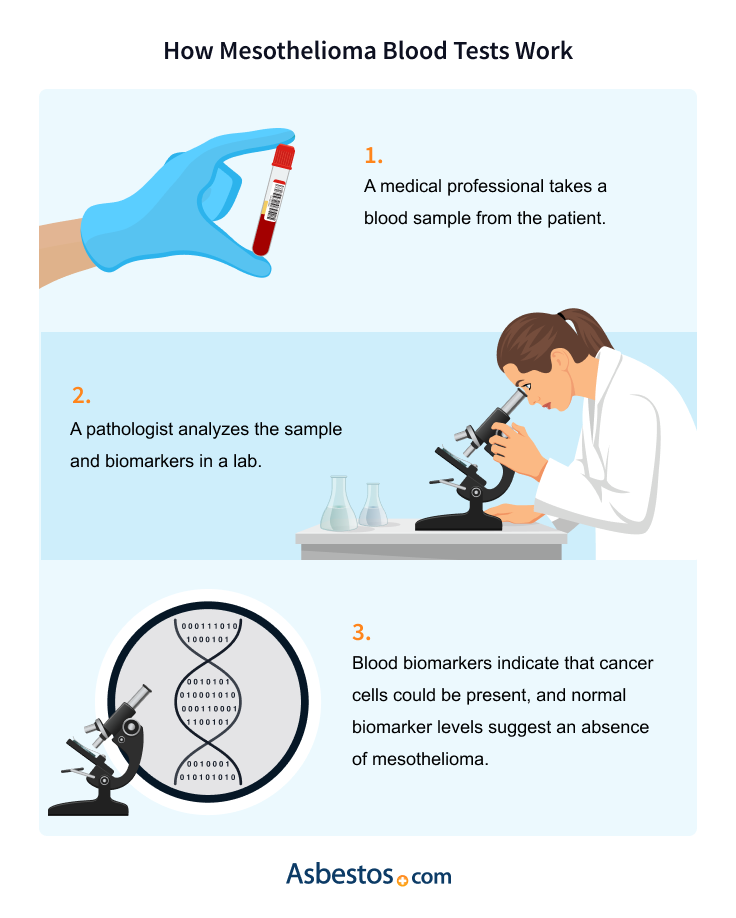Mesothelioma Blood Tests and Biomarkers
Mesothelioma blood tests find specific proteins related to the disease. These include n-ERC mesothelin and fibulin-3. Doctors use these tests, along with scans and biopsies, to confirm mesothelioma. The only FDA-approved blood test for this is the MESOMARK assay.
What Are Mesothelioma Blood Tests?
Blood tests for mesothelioma search for biomarkers made by cancer cells. However, these tests are not yet accurate enough to diagnose the disease on their own.
A direct blood test for mesothelioma isn’t available yet. However, blood tests can hint at cancer. Doctors also use imaging scans and biopsies to confirm asbestos-related diseases.
Chris Shelton, a survivor of mesothelioma, found out he had cancer after being in the hospital for over a month because of a severe motorcycle accident. During his stay, he underwent many blood tests to check his recovery and health. Finally, more tests revealed he had mesothelioma.
No blood test can detect asbestos exposure. Biopsy tests of tissues, however, can reveal the presence of asbestos fibers that can get stuck in tissues. Doctors often use biopsies to determine a diagnosis of mesothelioma.
The doctor came into my hospital room and said he had good news and bad news. He said, ‘You’ll walk again, but your blood work makes us think you have some sort of cancer.

How Do Mesothelioma Blood Tests Work?
Mesothelioma blood tests check for markers and proteins in blood and tissue that show health problems. For example, blood sugar and hemoglobin A1C are important for diagnosing and tracking diabetes. Cancer cells also release specific proteins into the blood.
Some tumors have unique biomarker proteins that are specific to the cancer. Finding them in a blood test suggests the person might have that cancer. Mesothelioma, however, is different. Its biomarkers are also found in healthy people. Yet levels are higher in those with mesothelioma. Despite this, the tests aren’t always accurate since they don’t provide definitive diagnoses.

Blood tests can confirm mesothelioma and rule out other cancers. Many cancers start in or spread to the lungs. Each cancer shows unique markers. Different cancers express different immunohistochemical markers, proteins that labwork can identify using antibodies.
There are no biomarkers specific to mesothelioma. But some proteins can help identify it. They are calretinin, cytokeratin 5 and 5/6, WT-1, podoplanin (D2-40) and mesothelin.
Dr. Snehal Smart of The Mesothelioma Center explained that blood tests can “help find mesothelioma in a patient before symptoms even begin.” Blood tests such as MESOMARK look for a particular protein – the SMRP protein.
Smart said this protein is “usually high in patients with mesothelioma.” Therefore, while a blood test such as a MESOMARK assay cannot diagnose a patient independently, “high levels of the SMRP protein can indicate a probable diagnosis of mesothelioma.”
Access top doctors, and get help scheduling appointments.
Connect NowDr. Jacques Fontaine, Pleural Mesothelioma Specialist

Common Mesothelioma Blood Tests
The MESOMARK, N-ERC/mesothelin and fibulin-3 tests are blood tests for diagnosing mesothelioma. Each has its pros and cons. However, they work best alongside biopsies and imaging studies.
A blood test must be sensitive, specific or both for it to be useful for diagnosis. A test with high sensitivity is better at detecting mesothelioma. A test with high specificity can help rule it out. Some tests are more sensitive than specific, and vice versa.
For example, the N-ERC/mesothelin test is very sensitive but not specific. When N-ERC/mesothelin levels are high, there’s a high likelihood that mesothelioma is present. However, a person may still have mesothelioma even if their N-ERC/mesothelin levels are low.
The fibulin-3 test, on the other hand, is very specific for mesothelioma. If fibulin-3 levels are low, there is little chance of mesothelioma. The N-ERC/mesothelin test can usually find mesothelioma. The fibulin-3 test can usually confirm you don’t have it.
All these blood tests use ELISA also known as an enzyme-linked immunosorbent assay. First, doctors collect a blood sample and send it to the lab. They mix it with antibodies for a specific biomarker. Then, the lab uses advanced equipment to measure the biomarkers in the blood.
MESOMARK Assay
The MESOMARK assay finds most mesothelioma types and tests treatment.
The MESOMARK test checks for soluble mesothelin-related peptides (SMRP) in the serum. These proteins are made by mesothelial cells. Healthy cells produce low SMRP levels. However, high levels may signal mesothelioma. Moreover, as treatment advances, SMRP levels drop.
Certain mesothelioma tumors, like sarcomatoid ones, don’t release much SMRP. So the FDA advises doctors to use the MESOMARK test alongside other tests for a precise diagnosis.
If you have a history of asbestos exposure, ask your doctor if the MESOMARK blood test would be helpful.
“A MESOMARK blood test is performed by the physician or nurse practitioner drawing a sample of blood. That blood is sent to a lab where the levels of SMRP protein are measured.”

N-ERC/Mesothelin Test
The N-ERC/mesothelin test finds a form called N-ERC/mesothelin. Similarly, MESOMARK also detects a specific type of mesothelin. This focus enhances their accuracy.
The test correctly identifies mesothelioma 95% of the time. However, it only rules it out 76% of the time. This is because of other cancers raising mesothelin levels. It’s more accurate than MESOMARK. Yet it can’t diagnose mesothelioma on its own.
Fibulin-3 Test
Mesothelioma cells create a protein named fibulin-3. We can detect this protein in pleural fluid and blood. Dr. Harvey Pass, a specialist in mesothelioma, played a key role in developing this test.
His study published in The New England Journal of Medicine found the test is 96.7% effective at detecting mesothelioma. It’s also 95.5% effective at ruling it out in healthy people.
Several researchers have found that the sensitivity of the fibulin-3 test can vary. This variation potentially makes the test less effective for detecting mesothelioma. However, it is still highly effective in ruling out mesothelioma.
Research shows that people exposed to asbestos have higher fibulin-3 levels. This means the fibulin-3 test is good for spotting significant asbestos exposure.Fibulin-3 levels can indicate mesothelioma prognosis. High levels signal a poorer outlook. Its testing works best with other blood tests.
Emerging Biomarker-Based Blood Tests
As researchers learn more about mesothelioma, they find new biomarkers that may improve its diagnosis and treatment. New biomarker tests can help diagnose mesothelioma. They can also distinguish it from other cancers. They can predict the disease’s outcome, choose the best treatment and track progress.
Dr. Aaron Mansfield, an oncologist at the Mayo Clinic Comprehensive Cancer Center, is leading a study on a new testing strategy for detecting mesothelioma in blood. The 2024 study published in Journal of Thoracic Oncology Clinical and Research Reports focuses on detecting complex DNA patterns in blood that could lead to earlier mesothelioma diagnosis.
Finding new biomarkers is crucial for understanding mesothelioma. Some, like YAP, are proteins that can make cells cancerous because they interact with DNA. These biomarkers can lead to new treatment targets, such as immunotherapy.
Newer Tests
- 8-Hydroxy-2′-Deoxyguanosine: 8OHdG, like fibulin-3, is higher in people who have been exposed to asbestos. It may be useful in identifying people at higher risk of mesothelioma and other cancers.
- Calretinin: Mesothelioma raises calretinin levels — the epithelioid type more than the sarcomatoid type. When combined with mesothelin tests, calretinin tests can help improve mesothelioma diagnosis accuracy and distinguish it from other asbestos-related diseases.
- Epidermal Growth Factor Receptor: EGFR levels are increased in mesothelioma (especially the epithelioid type) and some other lung cancers. EGFR may play a role in the development of mesothelioma. Clinical trials of mesothelioma treatments that target EGFR are ongoing.
- Estrogen Receptor-β: ER-β levels are elevated in some cases of mesothelioma. Research shows that people with mesothelioma who had high to moderate levels of ER-β responded better to chemotherapy and had better survival rates. Drugs that target ER-β can improve how well chemotherapy works.
- Megakaryocyte Potentiation Factor: Mesothelioma raises MPF levels. Like mesothelin, levels can decrease after surgery. This makes it useful to track treatment progress. When combined with tests for mesothelin and calretinin, MPF may be useful to help diagnose mesothelioma.
- Osteopontin: Research shows that osteopontin levels are higher in cases of both pleural and peritoneal mesothelioma as well as other cancers and tuberculosis. While it may not be useful for diagnosis, higher osteopontin levels can indicate a worse prognosis.
Some tests are available while others are still in the works. Soon, doctors may use these tests to catch mesothelioma early in symptom-free people. Early detection is key. It allows for timely treatment, which improves outcomes.
When you talk to your doctor about mesothelioma, ask about tests. Biomarker tests can improve decisions in diagnosis, treatment options, and ongoing care.
Recommended Reading



